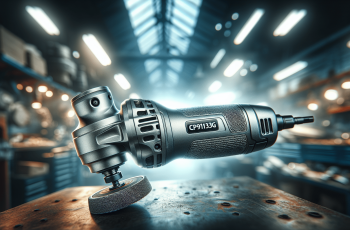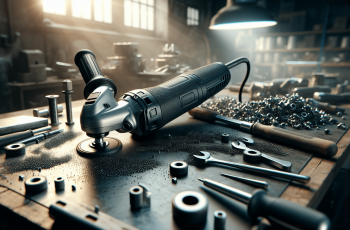Imagine you’re working on a project that demands precision and adaptability—enter the variable speed die grinder with cutting-edge speed control technology. These modern tools offer you the ability to effortlessly adjust speeds, enhancing precision across various materials. With adaptive control and smart integration, you’re not just using a tool; you’re experiencing innovation at your fingertips. Curious about how these advancements can transform your work? There’s more to discover.
Key Takeaways
- Advanced electronic controls allow precise speed calibration from 2,000 to 30,000 RPM for diverse applications.
- Innovations in variable speed triggers enhance adaptability, ensuring optimal performance for different materials.
- Load-sensing systems stabilize speed, enhancing safety and efficiency in variable speed die grinders.
- Smart integration with ONE-KEY™ facilitates real-time monitoring and tool management for improved operational efficiency.
- Ergonomic designs with AI optimization reduce user fatigue and enhance tool performance during extended use.
Evolution of Variable Speed Control in Die Grinders
The evolution of variable speed control in die grinders has been a journey marked by significant technological advancements and practical innovations. Starting in the early 20th century, when electric drills set the stage with their basic speed control challenges, the groundwork for future variable speed capabilities was laid. Historical advancements like the introduction of series motors in 1914 hinted at what’s possible. By the mid-20th century, high-speed tools emerged, reaching up to 25,000 rpm, pushing performance boundaries. With the shift of production from Europe and North America to China, the availability and variety of power tools, including die grinders with advanced speed control features, have expanded significantly. Technical challenges were met with ingenuity, as variable speed triggers and electronic controls replaced older methods. Manufacturers in Germany and the U.S. spearheaded these innovations, driven by safety needs and the demand for adaptable tools to handle diverse materials effectively.
Enhancing Precision With Multiple Speed Settings
With multiple speed settings, you can fine-tune your die grinder to suit the material you’re working on, ensuring ideal compatibility and reducing the risk of damage. This adaptive speed adjustment offers versatility across various applications, from gentle polishing to aggressive cutting. By selecting the appropriate speed, you’ll achieve precise results, enhancing both your project’s quality and efficiency. Electric Die Grinders, which operate with plug-in power, provide more torque, making them better suited for home shops where consistent power is needed for various tasks.
Precise Material Compatibility
Achieving precise material compatibility hinges on leveraging the multiple speed settings of your die grinder. Precision engineering plays a pivotal role here, allowing you to adapt the tool’s speed to suit various materials. Lower RPMs are perfect for delicate surfaces, reducing the risk of damage, while higher speeds tackle tougher metals efficiently. By choosing the right speed, you’ll enhance control over your cutting or grinding, ensuring a consistent finish. For different materials like steel or softer metals, select abrasives that complement the grinder’s speed settings. Aluminum oxide stones work well on steel at moderate speeds, whereas silicon carbide suits harder metals. Adjusting speed not only optimizes tool wear but also prevents issues like melting or distortion in plastics and soft metals. Ensuring accurate shipping details is also crucial for receiving the right tools needed for these precision tasks, as it contributes to overall customer satisfaction.
Adaptive Speed Adjustment
Building on precise material compatibility, adaptive speed adjustment in die grinders elevates your control and precision. By using advanced adaptive control mechanisms, you’re able to fine-tune speed calibration, ranging from 2,000 to 30,000 RPM, to match specific task demands. This flexibility through rotary dials or electronic triggers guarantees you can handle anything from delicate polishing to robust material removal.
With multiple preset speed levels, you can effortlessly switch between different operations, maintaining the right balance of speed and control. Lower RPMs support careful, intricate work, while higher RPMs facilitate quicker material removal without losing precision. Load-sensing systems maintain speed stability, enhancing safety and efficiency. The M18 FUEL™ Variable Speed Braking Die Grinder offers variable speeds ranging from 8,000-20,000 RPMs for precision and power. These smart adjustments extend the lifespan of your tools and accessories, optimizing performance and precision.
Versatility Across Applications
Although die grinders are often associated with industrial applications, their versatility across various tasks makes them invaluable tools for both professionals and hobbyists. With precise speed control, these tools adapt seamlessly to diverse application examples. In metalworking, they handle everything from deburring and weld clean-up to intricate internal grinding. Industry adaptations in the automotive sector include engine porting and rust removal, proving essential for performance and maintenance tasks. Woodworkers benefit from detailed carving and edge profiling, while stone artisans achieve exquisite stone carving and surface texturing. The ability to adjust speeds guarantees precision, reducing material damage and enhancing the quality of your work across different materials. Embrace these advancements to tackle any project with confidence and finesse.
Adaptive Control and AI-Driven Technologies
In the domain of modern die grinders, adaptive control and AI-driven technologies are revolutionizing the way these tools operate. With adaptive feedback, these systems maintain consistent power by dynamically adjusting to varying load conditions. This guarantees precision and a smoother finish, enhancing both performance and longevity. Intelligent calibration through AI allows for automatic optimization of grinding parameters, tailored to the material characteristics without manual intervention.
Wireless connectivity and AI algorithms empower you to track tool performance in real time, allowing predictive maintenance and minimizing downtime. You’ll experience enhanced safety with features like RAPIDSTOP™, which halts tools swiftly if risky conditions are detected. This combination of technology guarantees that your die grinder is always operating at peak efficiency, safety, and precision.
Ergonomic Design for Extended Use
When you’re using a die grinder for extended periods, comfort is essential to maintaining efficiency and reducing fatigue. Ergonomic designs utilize lightweight materials, anti-vibration features, and non-slip grips to enhance user comfort and minimize strain. By incorporating these features, you can work longer without compromising your well-being or productivity.
User Comfort Features
As you spend extended hours working with die grinders, user comfort becomes paramount to maintain both precision and efficiency. Ergonomic grip designs are essential user comfort features that enhance tool handling by reducing hand fatigue and improving control. Materials like rubber or composites absorb vibrations, while slip-resistant textures guarantee safety and stability. These grips are thoughtfully shaped to align with your hand’s natural contours, minimizing strain on fingers and wrists.
Lightweight designs, typically between 1 to 3 pounds, optimize weight and balance, reducing wrist strain and muscle fatigue. With the center of gravity near the grip, these tools enhance precision. Variations in size and shape, from compact to extended reach models, accommodate different hand sizes, improving usability in various tasks.
Extended Use Benefits
Although die grinders are indispensable for precision tasks, their prolonged use can lead to significant hand and wrist strain. Fortunately, advancements in ergonomic design offer solutions. The separation of the motor from the handpiece makes the tool lightweight, reducing strain during extended use. Slim grip profiles and soft-touch surfaces guarantee comfortable and secure handling, minimizing effort and risk of grip fatigue. Flexible shaft designs allow for greater freedom of movement, cutting down on awkward wrist angles and stress. These features, combined with user-friendly interfaces and variable speed control, contribute to sustainable performance. You’ll notice smoother speed adjustments and consistent operation under load, preventing muscle overexertion. Ultimately, these enhancements assure you maintain control and precision, even during long sessions.
Fatigue Reduction Strategies
Even with the best tools, prolonged use can lead to fatigue, but ergonomic design innovations in die grinders aim to minimize this risk. By integrating fatigue management strategies, these tools feature ergonomic tool enhancements that reduce strain. Slim, lightweight grips and well-balanced bodies improve control, while low-profile throttle levers promote a natural grip, minimizing awkward hand positions. Vibration dampers and noise-reducing technologies greatly lower muscle strain and auditory fatigue. Lightweight materials and compact designs facilitate easy maneuverability and lessen physical stress. Additionally, variable speed controls let you match RPM to task needs, reducing overexertion. Dustproof casings protect you from harmful particles, ensuring a cleaner environment and reducing respiratory strain. Together, these advancements support extended, comfortable tool use.
Importance of Material Versatility
Whether you’re working with metal, wood, plastic, or stone, material versatility is vital for maximizing the utility of your die grinder. With material adaptability, you can tackle diverse projects without switching tools, enhancing tool efficiency. High RPM capabilities allow precise material removal on delicate substrates, while interchangeable accessories like carbide burrs and sanding rolls guarantee you have the right tool for each task, whether it’s metal deburring or wood shaping.
Variable speed control is essential for adjusting to material hardness, preventing damage and extending tool life. The ergonomic design guarantees precision, allowing you to achieve smooth finishes and intricate details across various materials. This adaptability boosts productivity, streamlines workflow, and reduces costs, making it a cost-effective and efficient choice for any project.
Safety Innovations in Speed Control
Material versatility enhances a die grinder’s utility, but without proper safety measures, efficiency can quickly turn into risk. Prioritizing safety features is vital. Electronic overload protection, soft start systems, and restart prevention keep you safe from unexpected surges and restarts. Braking systems like RAPIDSTOP™ halt the grinder in under two seconds, minimizing hazard exposure. Physical safety features, such as ergonomic grips and dust filters, enhance user control and tool longevity.
Operator training is essential to prevent accidents. Understanding the function of paddle switches and brake mechanisms can greatly improve your handling skills. Proper use of personal protective equipment, like safety glasses and gloves, is a must. Being well-versed in these innovations guarantees safer operation and maximizes the tool’s potential.
Integration With Smart Technologies
Smart technologies are revolutionizing how we interact with and manage our tools, including die grinders. With smart integration, tools like the M18 FUEL™ Variable Speed Braking Die Grinder connect wirelessly to your smartphone via ONE-KEY™. This feature allows real-time monitoring and efficient tool management across job sites. You can track tool usage, monitor location, and even enhance security with alerts and tracking, reducing the risk of loss. The thorough inventory management system guarantees all your tools are accounted for, maximizing operational efficiency and productivity. With these advancements, you’ll experience cost savings and gain a competitive edge in the market. Smart integration not only optimizes performance but also makes die grinders more attractive for forward-thinking investors.
Future Trends in Speed Control for Industrial Applications
Building on the advancements in smart technologies, the future of speed control in industrial applications is poised for significant transformation. Imagine integrating Edge AI and machine learning for real-time processing, optimizing grinder speeds before faults occur, and boosting energy efficiency. These future applications will feature adaptive controllers that self-tune and embedded AI chips for quick decisions, setting new industry standards. Unified communication protocols will ease device integration into automation networks, allowing for remote adjustments and seamless interoperability. Energy-aware strategies will cut consumption and enhance sustainability. Meanwhile, cybersecurity advancements will protect against unauthorized access, and hardened modules will withstand industrial stresses. By embracing these trends, you’ll be ready to meet the evolving demands of the industry.
Conclusion
In exploring advancements in speed control technology for variable speed die grinders, you’ve seen how these innovations enhance precision, safety, and versatility. With adaptive controls and AI-driven technologies, you can effortlessly adjust speeds and work with a variety of materials. The ergonomic designs guarantee comfort during extended use, while smart technology integration elevates your experience. As you look to the future, expect even more sophisticated speed control features in industrial applications, further improving efficiency and user satisfaction.

